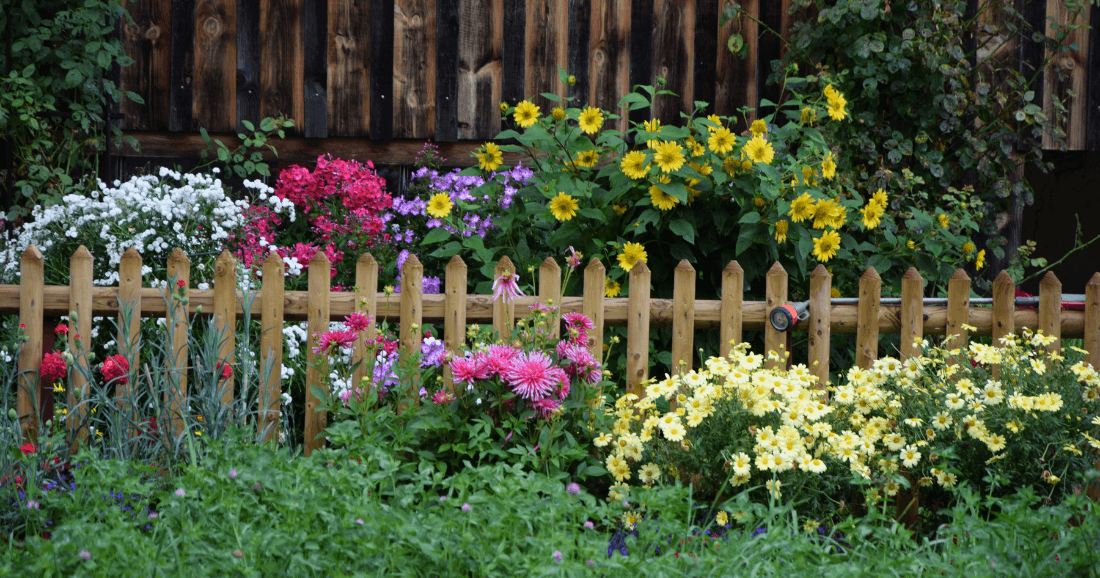If you're looking to add some life and charm to your fence, climbing plants are the perfect solution! They not only provide privacy and shade but also add a touch of natural beauty to your backyard.
In this article, we've rounded up 12 captivating climbing plants that are sure to make your fence stand out. We'll also provide you with some care tips to ensure your climbing plants thrive.

English Ivy (Hedera helix)
English Ivy is a classic climbing plant that is perfect for covering fences. It has glossy green leaves that turn reddish-brown in the fall, adding a touch of color to your yard. It's also an excellent option for shady areas, and it's known for its ability to purify the air.
Care tips
English Ivy prefers moist soil and partial to full shade. It can grow up to 50 feet long and needs to be pruned regularly to prevent it from becoming too invasive.
Climbing Hydrangea (Hydrangea anomala petiolaris)
Climbing Hydrangea is a stunning climbing plant that produces beautiful white flowers in the summer. It has heart-shaped leaves that turn yellow in the fall, making it an excellent option for adding some color to your fence in the fall.
Care tips
Climbing Hydrangea prefers well-draining soil and partial shade. It can grow up to 50 feet long and needs support as it grows. Prune it in the winter to promote healthy growth.

Wisteria (Wisteria sinensis)
Wisteria is a climbing plant that produces beautiful cascading flowers in shades of pink, purple, and white. It's perfect for adding some color to your fence in the spring.
Care tips
Wisteria prefers well-draining soil and full sun. It can grow up to 30 feet long and needs to be pruned twice a year to promote healthy growth.
Trumpet Vine (Campsis radicans)
Trumpet Vine is a climbing plant that produces beautiful trumpet-shaped flowers in shades of red, orange, and yellow. It's perfect for attracting hummingbirds to your yard.
Care tips
Trumpet Vine prefers well-draining soil and full sun. It can grow up to 30 feet long and needs support as it grows. Prune it in the winter to promote healthy growth.

Climbing Roses (Rosa spp.)
Climbing Roses are a classic climbing plant that produces beautiful roses in shades of pink, red, and white. They're perfect for adding some romance to your fence.
Care tips
Climbing Roses prefer well-draining soil and full sun. They can grow up to 20 feet long and need to be pruned regularly to promote healthy growth.
Jasmine (Jasminum spp.)
Jasmine is a climbing plant that produces beautiful white flowers that have a sweet fragrance. It's perfect for adding some perfume to your yard.
Care tips
Jasmine prefers well-draining soil and full sun. It can grow up to 30 feet long and needs support as it grows. Prune it in the winter to promote healthy growth.

Honeysuckle (Lonicera spp.)
Honeysuckle is a climbing plant that produces beautiful fragrant flowers in shades of pink, red, and white. It's perfect for attracting hummingbirds and butterflies to your yard.
Care tips
Honeysuckle prefers well-draining soil and full sun to partial shade. It can grow up to 30 feet long and needs to be pruned regularly to promote healthy growth.
Clematis (Clematis spp.)
Clematis is a climbing plant that produces beautiful flowers in shades of pink, purple, red, and white. It's perfect for adding some color and charm to your fence.
Care tips
Clematis prefers well-draining soil and full sun to partial shade. It can grow up to 20 feet long and needs support as it grows. Prune it in the winter to promote healthy growth and remove dead stems.
Virginia Creeper (Parthenocissus quinquefolia)
Virginia Creeper is a climbing plant that produces beautiful red and purple foliage in the fall. It's perfect for adding some color to your fence in the fall.
Care tips
Virginia Creeper prefers well-draining soil and full sun to partial shade. It can grow up to 50 feet long and needs support as it grows. Prune it in the winter to promote healthy growth.

Boston Ivy (Parthenocissus tricuspidata)
Boston Ivy is a climbing plant that produces beautiful green foliage in the summer and red foliage in the fall. It's perfect for adding some color to your fence in the fall.
Care tips
Boston Ivy prefers well-draining soil and full sun to partial shade. It can grow up to 50 feet long and needs support as it grows. Prune it in the winter to promote healthy growth.
Kiwi Vine (Actinidia spp.)
Kiwi Vine is a climbing plant that produces delicious kiwi fruits in the fall. It's perfect for adding some fruit to your yard.
Care tips
Kiwi Vine prefers well-draining soil and full sun to partial shade. It can grow up to 30 feet long and needs support as it grows. Prune it in the winter to promote healthy growth and increase fruit production.
Passionflower (Passiflora spp.)
Passionflower is a climbing plant that produces beautiful flowers in shades of purple, blue, and white. It's perfect for adding some exotic beauty to your fence.
Care tips
Passionflower prefers well-draining soil and full sun to partial shade. It can grow up to 30 feet long and needs support as it grows. Prune it in the winter to promote healthy growth.
By adding any of these 12 captivating climbing plants to your fence, you can add natural beauty and charm to your backyard. Just make sure to provide them with the proper care to ensure they thrive.
Extra Tip: Take Care of Your Plants With Liquid Humic Acid
If you're looking for an extra boost to keep your climbing plants and other garden greens healthy, you might want to consider using liquid humic acid. This natural compound is extracted from decaying organic matter and can help improve soil health, increase nutrient absorption, and boost plant growth.
One of the major benefits of using liquid humic acid is that it can help increase soil moisture retention, reducing the need for frequent watering. This is especially helpful during periods of drought or hot weather when your plants might struggle to stay hydrated.
In addition to improving soil moisture, liquid humic acid can also increase the availability of important nutrients like nitrogen, phosphorus, and potassium, which can help promote strong root growth and overall plant health. This can result in lusher foliage, more vibrant blooms, and a greater yield for fruit and vegetable plants.
To use liquid humic acid on your plants, simply dilute it with water according to the manufacturer's instructions and apply it to the soil around the base of your plants.
The frequency of application will depend on your specific soil conditions and the type of plants you are growing, but most experts recommend using it every 4-6 weeks during the growing season.
If you're looking for a versatile and cost-effective solution to improve the health of your plants, Humic Elite PG™ may be just what you need. This product is easy to use and can be applied to a wide range of growing applications, from lawns and gardens to crops and agriculture.
One of the key benefits of Humic Elite PG™ is that it can help improve soil structure, allowing for better water retention and nutrient absorption. This can result in healthier, more robust plants that are better equipped to resist stress and disease.
Frequently Asked Questions
How do I choose the right climbing plant for my fence?
Consider the amount of sun exposure your fence gets, the type of soil, and the amount of space available for the plant to grow.
Do climbing plants damage fences?
Some climbing plants, such as English Ivy, can damage fences if not pruned regularly. Make sure to research the specific climbing plant and provide proper support and maintenance.
How often do I need to water climbing plants?
It depends on the specific climbing plant and the climate. Generally, climbing plants need to be watered regularly, especially during hot and dry weather.
Can climbing plants attract pests?
Yes, climbing plants can attract pests such as aphids and spider mites. Make sure to regularly inspect your climbing plants and use natural pest control methods if necessary.
How can I prevent my climbing plant from becoming too invasive?
Regular pruning and providing proper support can prevent climbing plants from becoming too invasive. Make sure to research the specific climbing plant before planting it to ensure it's the right fit for your fence and yard.
Conclusion
Adding climbing plants to your fence can be a fantastic way to enhance the look and feel of your outdoor space. Not only do they add a touch of natural beauty, but they can also provide shade, privacy, and a home for wildlife.
With so many options to choose from, it's important to consider factors such as your climate, sunlight exposure, and maintenance needs before making your selection.
By following the care tips outlined in this article and selecting the right plants for your fence, you can create a stunning and thriving garden that will bring joy to you and your visitors for years to come.

